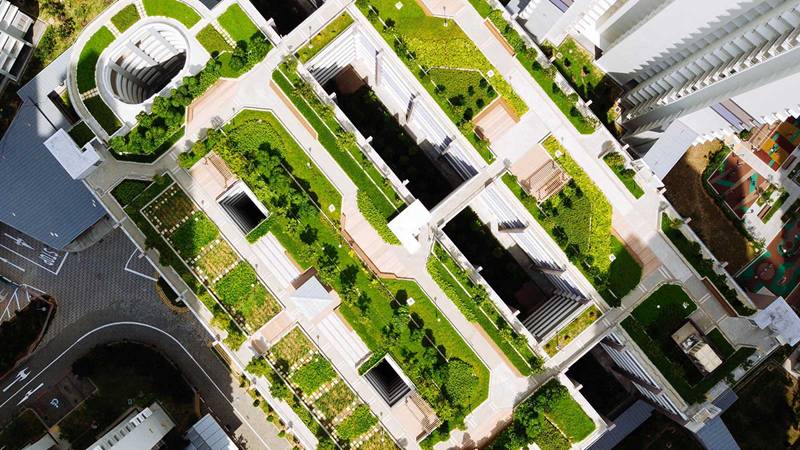How the built environment can lead the way on biodiversity
When it comes to sustainability, as an industry we often find ourselves focusing on energy, carbon, water and waste. As a result, biodiversity is often unfairly pushed down the agenda, despite its importance.
But what is biodiversity? It’s a term not easily explained but on a basic level, it could be defined as the web of life, in all its forms and all its interactions. This ranges from genes to species to ecosystems – everything that collectively forms the biological diversity of the globe. It matters because it supports the vital benefits we all get from the natural environment. It contributes to our economy, our health and wellbeing; it is key to our survival.
As such, the decline of biodiversity has serious consequences and its protection and enhancement is essential if we are to achieve a sustainable future. Research suggests that by 2050, 90% of animals are expected to lose some of their natural habitat due deforestation, pollution, pesticides, climate pressures and disappearance of waterways, while the effect of new developments on green spaces only further increases that loss.
New preventative regulations are being advocated for across Europe and in the UK, with the Environmental Bill (first read in the House of Commons in January 2020) proposing the introduction of several new laws designed to protect the environment. One such measure is mandatory biodiversity net gain for new construction developments. With this proposal likely to be ratified in Q4 2023, what does this mean for the future of the built environment?
New measures
Firstly, it is important to distinguish biodiversity net gain that is delivered through development/construction (which are biodiversity offsets) and biodiversity gain delivered as part of a business’s nature positive journey - an investment in nature’s recovery rather than an offset for damage.
But ostensibly, biodiversity net gain is the promise of the construction industry to limit its impacts on biodiversity, whilst still being able to complete projects of crucial importance - some of which will provide enormous benefits to society like new hospitals and accommodation. Like humans, animals and plants need homes too.
Between 2009-2019, approximately 44% of UK species have decreased in numbers. So the aim of the biodiversity net gain delivered through development is to ensure that when a new development project is completed that there is a positive outcome for biodiversity with more potential habitats for animals and plants to thrive than before the development began - hence a gain in biodiversity.
The potential to make an impact is there. According to The UN Environment Programme World Conservation Monitoring Centre, restoring 30% of lands that have been converted for farming into biodiversity priority areas, whilst retaining natural ecosystems, would prevent over 70% of projected extinctions of mammals, birds and amphibians. At the same time, restoring these priority lands would also put us on track to sequester almost half of all the CO2 increase in the atmosphere since the Industrial Revolution - more than 465 billion tons.
In service of these benefits, the construction industry will soon need to prove that they are taking the right initiatives when applying for planning permission. Some of the specific regulations that need to be complied with by developers include a minimum of 10% net gain in the biodiversity created and that those habitats must be secured for at least 30 years. In theory, the new measures should aid in ensuring that less habitats are destroyed, a decrease in biodiversity loss and more green spaces for communities to enjoy. However, at present, how the measures are going to be regulated and enforced is still under consultation.
Biodiversity in practice
On a more global level, the UN Biodiversity Conference (COP15) is just one month away and is set to define the future of the world's biodiversity, setting action targets for 2030. Headline draft targets will aim for conservation of at least 30% of land and sea areas globally, restoration of at least 20% of degraded freshwater, marine and terrestrial ecosystems. Importantly all businesses will be required to assess and report on their dependencies and impacts on biodiversity and progressively reduce negative impacts and increase positive impacts.
However, even now, one of the clearest ways in which the built environment can raise the profile of biodiversity in urban areas is through habitat modification and taking advantage of existing space at the top of new and existing buildings. From the development of green spaces like public parks, to the construction of green walls and roofs, these spaces can provide refuge for displaced wildlife and play an vital role within urban ecosystems.
With this in mind, Mace recently partnered with the Lancashire Wildlife Trust to restore 157 hectares of Greater Manchester’s lowland mosslands in the UK. This will see the repair of the habitats of many endangered and rare species of plants and animals. Under the new partnership, Mace will provide funding, expertise on nature-based solutions and staff to volunteer on the restoration of biodiversity as part of the Maximising Manchester’s Mosslands project.
There are further practical approaches that can be implemented too (like indoor and outdoor planting regimes and beehive installations,) but if we are to be truly successful we have to do more to raise awareness of the importance of biodiversity among both our own staff and our suppliers. The industry must be encouraged and incentivised to develop site-specific strategies for managed assets, with the aim of achieving enhancements for selected species and/or habitats identified in local, regional or national biodiversity action plans. It needs to become standard practice to collect biodiversity data (e.g. number of plant types considered pollinators sightings of protected species etc) and report to local authorities and, where necessary, other bodies, based on the data collected.
In the wake of COP27 and as COP15 approaches, the built environment has an opportunity to become leaders as protectors and creators of biodiversity. While the construction industry can only be described as an indirect driver of the issue, biodiversity is becoming a core issue for many of today's major economic sectors, increasingly a heading in policies for corporate environmental responsibility and will soon impact upon how companies commission their buildings. It’s time to get prepared.












